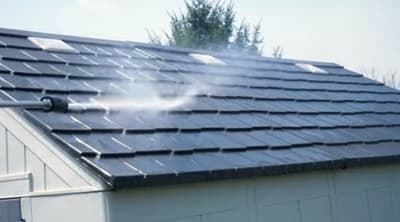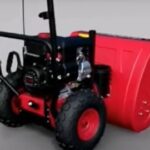As an Amazon Associate, this site earns commissions from qualifying purchases. For more information click here.
You just turned on your pressure washer and no water comes out. Or perhaps there is, but it is a trickle. Or maybe the water pressure suddenly drops. These are problems pressure washer owners will come across at one time or another. The good news is you can fix most of these issues without calling a professional.
If your pressure washer has no water output, the inlet filter is probably clogged. Cleaning it should fix the problem. If the pump is making weird sounds and there is no water pressure, ice has formed in the pump and might have damaged some parts.
Clogged Inlet Filter
There are many possible reasons why no water is coming out of your pressure washer, but a clogged inlet filter is the most likely. The inlet filter filters the water that goes into the pump, preventing debris from getting in.
Through constant use, this filter gets filled with dirt. If the filter is clogged up water cannot flow. To find out, get a garden hose and connect it to the inlet filter.
If water flows, the filter is fine. If not, it has a blockage. Clean the filter and try it again. While you are at it, it is a good idea to clean the air filter too to eliminate the dirt and dust.
If this does not work, the hose might be crimped or you have a clogged wand. Fix the hose and check the wand if there is blockage.
Check the Water Supply
Electric pressure washers need at least 1.5 GPM while gas pressure washers require 2.5 GPM. If the water is insufficient it will not run correctly. Even if the filters are clean and the pump is fine, it will not run without adequate water supply.
You can test the water supply by following these steps. First you will need a timer and a 25 ft. hose with a 3/4 inch diameter.
Get a 5 gallon bucket if you have a gas pressure washer. If you can fill the bucket up to 50% capacity in 60 seconds or less, the GPM is enough. If you are unable to do so, the water supply is not sufficient for the pressure washer.
Get a 2 gallon bucket if you are using an electric pressure washer. If you can fill the bucket with water 3/4 full, the GPM is adequate. But if you cannot, the supply is not enough for this pressure washer. If you have a powerful model like the Greenworks 1600 PSI, this is a necessary test.
Frozen Water in Pump
If your pressure washer has no water flow and the pump is making loud noises, there could water frozen inside it. This happens a lot and can cause severe damage.
This usually occurs when you forget to empty the pressure washer before winter. If you do not put antifreeze, water will likely be left inside. This water turns into ice during winter, clogging the pump and probably damaging it.
The best option is to replace the pump. Unless you are a DIY expert it is better to buy a replacement than attempt to fix it.
Worn Out Nozzle
Water output could slow or stop if the nozzle is worn out or clogged. The most obvious sign is little to no water coming out, but a clogged nozzle also produces unusual spray patterns.
If the water output suddenly stops the nozzle is probably clogged. If the pressure is slowly weakening, the nozzle is worn out. The holes in a worn out nozzle widen, which allows more water to flow while losing pressure.
If the water output just stopped, remove the nozzle and look for signs of clogging. If the pressure loss is gradual, replace the nozzle with a new one. So if the pressure goes back to normal, it means the old nozzle was indeed worn out. You can replace them with the Twinkle Star nozzle tips set which has the tips most commonly used by pressure washers.

Problems with the Hose
There are many possible problems with the hose which will affect water pressure. The following are the most common.
A crimped hose prevents water from flowing out of the nozzle. Fix any crimp and also inspect the hose for clogging.
Most pressure washers work with a 3/4 inch diameter hose instead of 5/8. If you are replacing the hose, make certain that it is 3/4 inches. Any other diameter and it will change the water output coming out of the pressure washer.
The hose could also be leaking. Check the O-ring and replace it with a new one if it is showing signs of wearing out.
Adjust the Unloader Valve
The main purpose of the unloader valve is to set the water flow to bypass when it is not being used by the nozzle. You can also use the valve to reduce or increase water pressure that goes into the nozzle.
Unloader valves on different pressure washers have the same functions but how you adjust water pressure depends on the manufacturer design. If water output is weakening, check the nozzle for signs of wear and tear.
Adjust the unloader valve in increments, otherwise you risk increasing the pressure too much. Some pressure washers have a gauge so you can see the effects right away. You can only adjust the unloader valve when the pressure washer is on and the wand is being pulled.
If you adjust the unloader valve and it does not work, the valve is probably damaged. Fix or replace the valve as soon as possible.
Pressure Regulator Problems
Some pressure washers use a pressure regulator rather than an unloader valve. They perform the same role, but an unloader valve has a contraption which holds the pressure between the nozzle and the valve.
What this mechanism does is ease the pressure from the pump when the trigger wand pressure is let go and the water flow ceases. A pressure regulator diverts water flow but does not prevent pressure from reaching the pump. This can wear the pump out soon and require repair or replacement. Depending on the pressure washer, you might be able to adjust the pressure regulator settings.
Most pressure washers today use an unloader valve due to the problems inherent with a regulator. But as pointed out earlier, unloader valves can have issues too so you have to keep an eye on them.
If you are not sure, check the operating manual. Since most pressure washers today come with different nozzles, this is less of a problem. If you want to adjust the pressure, you can replace the nozzle rather than adjust the unloader valve or pressure regulator.
Other Fixes and Solutions
If the suggestions above do not fix the problem, try the following. These are applicable to all types of pressure washers so they are worth a try.
Boost the throttle. Sometimes the throttle speed is too low and limits the water flow. Set the throttle to high and you should see water flowing out of the nozzle.
Add oil to the pump. The pump needs oil to run. Not enough oil and the water pressure will drop or cease altogether. Make sure you use only the oil the manufacturer recommends.
Check the PSI level. Most pressure washers need at least 20 PSI to run. Even if the pump, nozzle and hose are working, a low PSI will always lead to low or no water pressure.
The water could be too hot. Most pressure washers can only handle water up to 100 F/ 37.7 C. For best results, the water temperature should be lower than that.
Note that some pressure washers can handle hot water. Not all of them do however, so check the owner’s manual to know for sure. Do not use hot water unless you are certain it is acceptable.
Leaking spray gun. If the spray gun is leaking or damaged, water flow will be restricted or irregular. Replace it right away.
Use a high pressure nozzle. Pressure washers usually come with four nozzles, black, white, green and yellow. Black nozzles have the lowest pressure and yellow the highest. Try switching to a higher pressure to see if it helps.

I love the outdoors and all the tools for maintaining gardens, yards and lawns. The only thing I am more passionate about is sharing what I know about garden and outdoor equipment.


